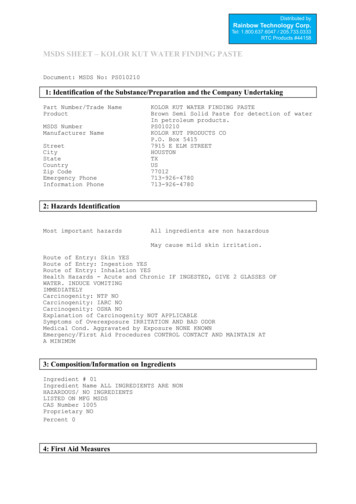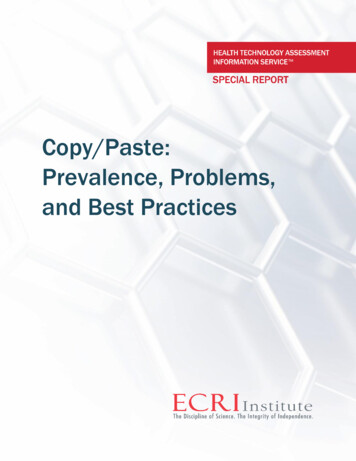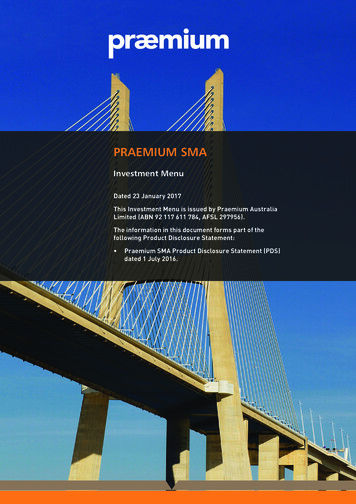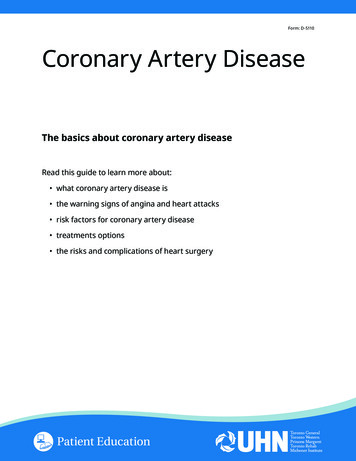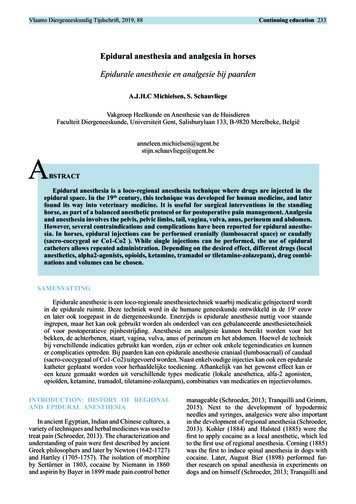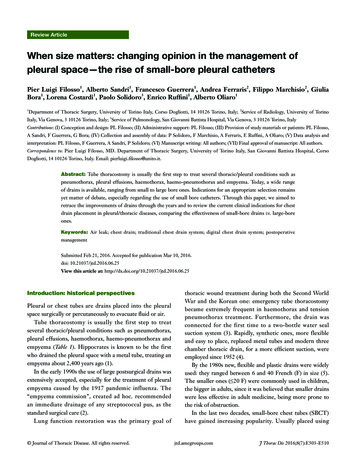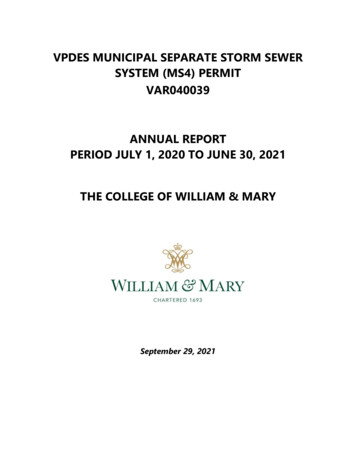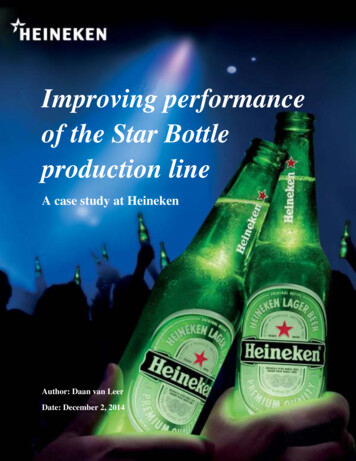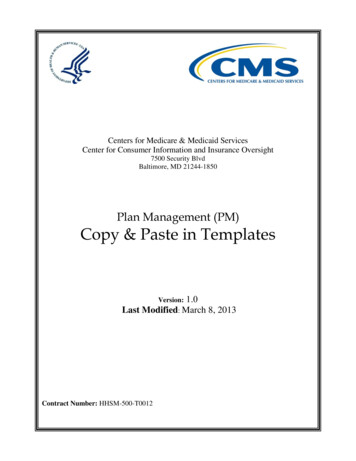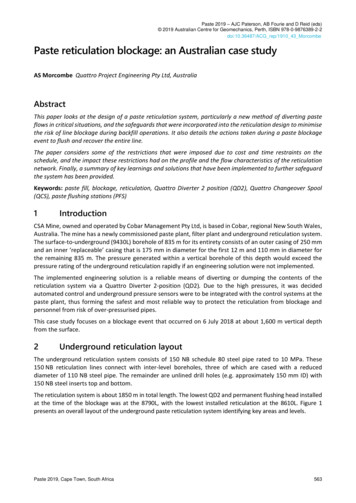
Transcription
Paste 2019 – AJC Paterson, AB Fourie and D Reid (eds) 2019 Australian Centre for Geomechanics, Perth, ISBN 978-0-9876389-2-2doi:10.36487/ACG rep/1910 43 MorcombePaste reticulation blockage: an Australian case studyAS Morcombe Quattro Project Engineering Pty Ltd, AustraliaAbstractThis paper looks at the design of a paste reticulation system, particularly a new method of diverting pasteflows in critical situations, and the safeguards that were incorporated into the reticulation design to minimisethe risk of line blockage during backfill operations. It also details the actions taken during a paste blockageevent to flush and recover the entire line.The paper considers some of the restrictions that were imposed due to cost and time restraints on theschedule, and the impact these restrictions had on the profile and the flow characteristics of the reticulationnetwork. Finally, a summary of key learnings and solutions that have been implemented to further safeguardthe system has been provided.Keywords: paste fill, blockage, reticulation, Quattro Diverter 2 position (QD2), Quattro Changeover Spool(QCS), paste flushing stations (PFS)1IntroductionCSA Mine, owned and operated by Cobar Management Pty Ltd, is based in Cobar, regional New South Wales,Australia. The mine has a newly commissioned paste plant, filter plant and underground reticulation system.The surface-to-underground (9430L) borehole of 835 m for its entirety consists of an outer casing of 250 mmand an inner ‘replaceable’ casing that is 175 mm in diameter for the first 12 m and 110 mm in diameter forthe remaining 835 m. The pressure generated within a vertical borehole of this depth would exceed thepressure rating of the underground reticulation rapidly if an engineering solution were not implemented.The implemented engineering solution is a reliable means of diverting or dumping the contents of thereticulation system via a Quattro Diverter 2-position (QD2). Due to the high pressures, it was decidedautomated control and underground pressure sensors were to be integrated with the control systems at thepaste plant, thus forming the safest and most reliable way to protect the reticulation from blockage andpersonnel from risk of over-pressurised pipes.This case study focuses on a blockage event that occurred on 6 July 2018 at about 1,600 m vertical depthfrom the surface.2Underground reticulation layoutThe underground reticulation system consists of 150 NB schedule 80 steel pipe rated to 10 MPa. These150 NB reticulation lines connect with inter-level boreholes, three of which are cased with a reduceddiameter of 110 NB steel pipe. The remainder are unlined drill holes (e.g. approximately 150 mm ID) with150 NB steel inserts top and bottom.The reticulation system is about 1850 m in total length. The lowest QD2 and permanent flushing head installedat the time of the blockage was at the 8790L, with the lowest installed reticulation at the 8610L. Figure 1presents an overall layout of the underground paste reticulation system identifying key areas and levels.Paste 2019, Cape Town, South Africa563
Paste reticulation blockage: an Australian case studyFigure 13AS MorcombeSchematic diagram of the CSA underground paste reticulation systemInstalled Quattro Diverter 2 positionThrough extensive flow modelling, the first three QD2s were installed at strategic locations, the first of whichwas located at the bottom of the surface-to-underground borehole (9430L). Figure 2 shows the installed QD2at the 9040L. Paste enters the diverter from the rear and either flows inline or is diverted to a dump locationas required during an emergency dump situation.A Vegabar82 pressure sensor is incorporated into the paste line, reporting back to the control boxes of eachQD2 and to the surface paste plant control system to allow real-time pressure monitoring of the paste systemand also to initiate an ‘emergency dump sequence’ if a set maximum pressure is detected. Each QD2 has aclosed circuit with a pressure sensor, pressure switch, UPS battery backup system and an individual dedicatedair receiver to enable the QD2s to automatically divert the paste stream to a dump location in the event of asystem over-pressure situation. Over-pressure can cause consequences such as concurrent power failure, lossof air supply or loss of communication with the paste plant control system (such as a severed fibre optic cable).One of the most attractive benefits of the automated dump function at the mine is the instant response to apressure spike; the QD2 can be pre-set to actuate at any predetermined pressure. The QD2s are also fitted564Paste 2019, Cape Town, South Africa
Transportationwith a pressure-welded flushing head with non-return valves (to prevent filling the mine services with paste)and were plumbed into the mine’s water supply and air supply services at each QD2 location, thus formingan underground flushing system. A mobile flushing head for use at any other location in the system was fittedwith 25 mm air and water fittings. Detailed operational procedures were in place for a blocked line scenariowith predetermined set points for alarms and auto dump functions.Figure 24QD2 installed in the backs at the 9040LThe blockageOn 6 July 2018 at 12.40 am, the lowest installed pressure sensors on the QD2s at 8790L and 9040L spikedfrom a normal operating pressure of 0.5–8 MPa within four minutes, triggering automatic dump sequences.The QD2 at 9430L (the base of the borehole) spiked from a normal operating pressure of about 3–10 MPa ina matter of seconds, also triggering an automatic dump sequence. Figure 3 provides a graphicalrepresentation of the pressure versus time recorded by the various pressure sensors during the event. It canbe observed that the pressure sharply rises in all three locations in a short period of time.The pressure spikes reached the auto dump sequence set point of 8 MPa nearly simultaneously, initiating thepaste plant to commence an immediate shutdown and all three QD2s to divert to their respective dumppositions. This action allowed the paste to discharge from the reticulation system in seconds, dropping thepressure back to zero.Once the line pressures had dropped below 8 MPa, the paste plant operator initiated the ‘blocked line’protocol. Starting in a top-down manner, the paste plant operator flushed each section of the reticulationclean with 5 m3 of water, followed by air, ensuring each section was fully recovered before closing the QD2and flushing to the next QD2 location. This process took about 20 minutes to complete and the reticulationwas confirmed clear from the surface down to the last QD2 location (8790L). Essentially, three-quarters ofthe 1,850 m reticulation system, including an AUD 2 million borehole, were saved in a matter of minutessafely, efficiently and effectively.Paste 2019, Cape Town, South Africa565
Paste reticulation blockage: an Australian case studyFigure 3AS MorcombePressure versus time graph during the blockage (MPa, 8790-Red, 9040-Green 9430-Blue)Once the reticulation had been cleared and flushed clean to 8790L, the paste plant operator began flushingthe remainder of the system, which had no QD2 or instrumentation installed at that stage. After attemptingto flush to the fill location on 8670L for 40 minutes without movement, the balance of the reticulation wasnow considered to be blocked.Once the lower section of the reticulation was considered blocked, the underground paste crew and pasteforeman commenced a manual unblocking sequence and began using the mobile flushing head to flush thereticulation system. An attempt was made to flush the system from 8670L to 8700L with a mobile flushinghead (Figure 4) with no success. The mobile flushing head was attached to the reticulation at 8700L and thatlevel was successfully flushed. An attempt was then made to flush from 8700L to the fill point at 8670L withno success. It is worth noting that at this stage five hours had passed, and the binder content was relativelyhigh, resulting in the paste curing inside the pipe.Moving down to 8670L, the elbow joining the 8670 to 8700 inter-level boreholes was removed, whichallowed the paste to flow out with the assistance of gravity. The mobile flushing head was only able to flush20 m sections as the paste was at an almost solid consistency by this time.Underground firing was postponed as per the procedure and the operators were hot seated underground sothe clearing of pipes could continue into the next shift without losing any more time. The pipes were brokeninto 6–12 m lengths for flushing with the mobile flushing head. The paste had cured very close to solid by theend of the day shift; however, the underground crew was able to fully clear the reticulation system.Note: The post-incident investigation found that an unlined inter-level borehole failure was the cause of theblockage. The inter-level borehole between 8700L and 8730L had to be redrilled as a result. The whole pastefill system was operational again within three days.566Paste 2019, Cape Town, South Africa
TransportationFigure 4QD2 with flushing head attachedThe flushing heads shown in Figure 5 were custom designed for the project. The larger flushing head isconnected to each QD2 to flush the downstream line when the QD2 diverts into dump position, while thesmaller flushing head is a mobile unit that can be taken to an intermediate location. The units are designedfor 7 MPa pressures while the connecting end is grooved to suit the reticulation coupling to attach effectivelyto underground pipe work.Figure 5Flushing head units for attaching to QD2, Quattro Changeover Spools and underground pastepipesPaste 2019, Cape Town, South Africa567
Paste reticulation blockage: an Australian case study5AS MorcombeConclusionOnce an investigation was completed, several issues were identified: Excessive loss of reaction time was experienced during the manual unblocking sequence due tolimited tooling, and the time for tramming integrated tool carriers from location to location overlarge distances and searching for other equipment such as work baskets. The splitting of resourcesto work above and below the failed borehole also contributed to the delays. The ability toautomatically unblock the upper levels using the QD2s mitigated these delays to a great extent. The lower inter-level boreholes are 30-40 m in length and it became apparent that with theprogressive curing of the paste, its flow ability became almost non-existent. Thus, the only way todump or evacuate paste from the lower inter-level boreholes was for personnel to manually openthe pipe at the couplings. This was not ideal. Although the paste line was isolated, the inter-levelborehole still potentially had stored energy from the available hydraulic head of the paste of around40 m. The release of stored energy along with ‘springing’ of the pipe work (a movement of the pipeswhich is common in many paste fill reticulation system) creates a less than desirable environmentfor personnel to be working in. It had been proven onsite prior to the blockage that if a flushing head is used while the paste is stillrelatively fluid (up to four hours), a single flushing head is capable of flushing multiple levels cleanat a time. With the slower manual unblocking process and associated delays, the paste backfill inthe lower sections experienced some curing, leading to reduced efficiency of the flushing headsthat were ultimately limited to flushing 20 m sections.The ability to isolate the QD2s underground to allow personnel to start working on the blocked reticulationproved to be invaluable. If this were not possible, it would have required a two-hour round trip every timethe paste reticulation system needed to be isolated on the surface. The blockage and subsequent reaction tothe blockage was considered a success.To rectify highlighted risks to the paste fill operation and personnel, extensive upgrades to the infrastructurein the lower levels and the blockage reaction plan or ‘emergency blockage procedure’ have taken place.A change of management plan was conducted, resulting in the decision to install paste flushing stations (PFS)at strategic locations of high value or risk. This PFS consists of a permanently installed QD2 or a QuattroChangeover Spool (QCS) as shown in Figure 6, with a flushing head plumbed into the mine’s water and airDN63 services. This equipment is accessed from an aluminium work platform (Figure 7) on a concrete pad2.5 3.5 m, enabling personnel to work on the reticulation safely. This also negates the need for an integratedtool carrier to be used, saving valuable time at the most critical juncture of a blockage. The platform is costeffective, lightweight enough to be moved by hand if necessary, does not need personnel to have any specifictraining to assemble, and has a working height of up to 5.3 m.568Paste 2019, Cape Town, South Africa
TransportationFigure 6QCS – manual changeover spoolFigure 7Shows the platform and concrete pad used as part of a paste flushing stationPaste 2019, Cape Town, South Africa569
Paste reticulation blockage: an Australian case studyAS MorcombeThe benefits of the PFS means that any stored energy can be bled or released safely via the installed QCS/QD2and has the advantage of having the permanent flushing head attached for immediate use. Adding a workplatform to this installation, along with the ability for personnel to isolate the QD2 from the control box(Figure 8) on ground level, means an extremely fast reaction time to any line blockage.Figure 8QD2 underground control panel with UPS, closed communications circuit and air receiverTo complement the six PFSs installed so far, two mobile flushing heads and two locked toolboxes with all theequipment needed are located underground in the event of a future blocked line emergency.A well-planned emergency procedure to help overcome a stressful situation (blocked paste line) with highpotential losses is essential. It is also critical that the procedures define the paste plant operator’s actions atcritical junctions early in the blockage. An isolation protocol with multiple crews working at the same timeand a clear action plan for clearing the blockage is also essential. The procedure has subsequently beenrefined and updated to make it possible for supervisors, who may not have a lot of exposure to the day-to-dayoperations of paste fill, to deploy the procedure and direct multiple crews who themselves may not workdirectly within the paste fill department. This allows 24-hour coverage of the paste fill operation.AcknowledgementThe author thanks Quattro Project Engineering for the continual support, innovative products line and foralways looking at problems as a potential opportunity to find and implement a solution; and CobarManagement Pty Ltd CSA Mine NSW Australia’s management team for always being ready to support andproactively pursue practical solutions throughout the project.570Paste 2019, Cape Town, South Africa
A Vegabar82 pressure sensor is incorporated into the paste line, reporting back to the control boxes of each QD2 and to the surface paste plant control system to allow real-time pressure monitoring of the paste system and also to initiate an 'emergency dump sequence' if a set maximum pressure is detected. Each QD2 has a
